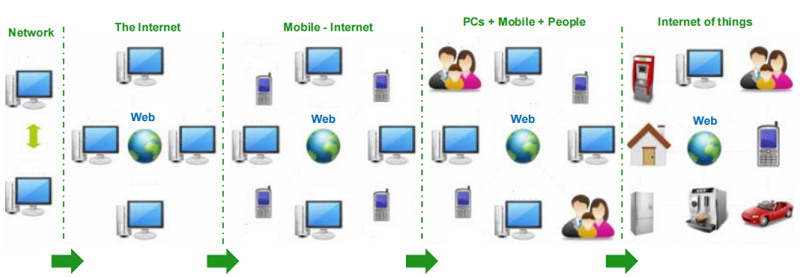Home »
IoT (Internet of Things) Tutorial
IoT (Internet of Things): Evolution and History
IoT Evolution and History: In this tutorial, we will learn about the evolution and history of IoT (Internet of Things) along with the phases of evolution.
By Shahnail Khan Last updated : August 12, 2023
Evolution of IoT
Did you ever imagine the things that were invented a few decades back could be interconnected to each other through technology? Well, you heard it right. With the advancement in technology, things now started communicating with each other via networks. The technology that made it possible is the "Internet of Things" or IoT. A network of physical objects (having sensors) that can be accessed through the Internet is what an IoT refers to.
Phases of Evolution

This picture very well depicts the evolution of IoT over the past years. Before diving deep into the history of IoT, let's understand what this image tells us. In the first phase, we can see only two computers are connected to the network. Then, in the second phase, the framework of the World Wide Web was proposed, which is like the foundation of the Internet we use today. After this phase, PCs, mobile and even people began using the Internet, marking the onset of a groundbreaking revolution. The most recent era witnessed the emergence of IoT technology, which connects almost everything in our environment to the Internet.
History of IoT
There have been substantial technical advances and changes in how we engage with the digital environment throughout the history of the Internet of Things (IoT). The development of IoT may be broken down into different stages over the course of several decades and are characterised by the advent of new technologies and shifting user behaviours.
IoT was first established in the late 1960s and early 1970s, at which time key technologies including TCP/IP, Telenet, and Ethernet were created. The development of the communication protocols that will eventually support the interconnectivity of devices was the primary emphasis of this early stage. It was a turning point when full-text online search engines first appeared in 1994 because they created the framework for effective information retrieval on the expanding internet.
IoT began to gain popularity among early adopters and technology enthusiasts in the late 1990s and early 2000s. The first step in developing a commercial internet ecosystem was characterised by Amazon's entry into online retail in 1995 and the emergence of eBay. Online communication, information discovery, and safe transactions were further enhanced by innovations like Hotmail, Google Search, and PayPal.
The mainstream adoption of the internet into daily life occurred between 2000 and 2007. People gained the ability to collectively produce and access knowledge on a worldwide scale with the advent of Wikipedia in 2001. The introduction of social media behemoths like Facebook, YouTube, and Twitter in 2004 revolutionised how we share and consume material, creating a feeling of global connection among users. With the rise of smartphones, the attention switched from 2007 to 2011 to the mobile internet. Cellular internet connectivity made it possible for individuals to stay in touch while on the road, hastening the adoption of digital technology in daily life.
In 2012, the Internet of Things era started to take off. Devices may interact and share data on their own during this phase thanks to seamless connections to the internet and other devices. Beyond conventional computers and cellphones, a wide range of items from domestic appliances to industrial machinery are now connected. The IoT age has opened up new opportunities for automation, data-driven insights, and increased convenience from smart homes to smart cities and beyond.
In essence, the development of fundamental technologies and the widespread use of networked devices are reflected in the history of the Internet of Things. Every stage has influenced the digital environment we live in today, highlighting the rapid advancement of technology and its significant social impact.
Conclusion
In conclusion, the development of the Internet of Things (IoT) is evidence of technology's incredible advancement and its profound impact on our world. The development of the Internet of Things (IoT), from its modest beginnings anchored in communication protocols to the seamless interconnection of gadgets we experience today, highlights the never-ending quest for innovation and the limitless potential of human creativity.
The development of IoT throughout time has followed a path that has been influenced by both new technology developments and changes in consumer behaviour. Every stage, from the development of the first networking protocols to the widespread use of smartphones and the ensuing explosion of connected devices, has had a profound impact on the way we live, work, and interact with our environment.
Advertisement
Advertisement